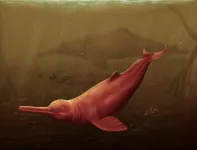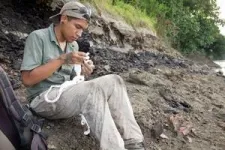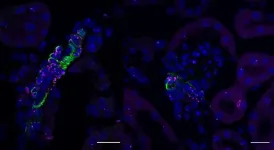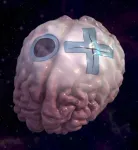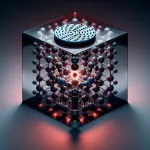(Press-News.org) Measuring between 3 to 3.5 meters, 16 million years old: Paleontologists from the University of Zurich have announced the discovery of a new species of freshwater dolphin in the Peruvian Amazon region. Surprisingly, its closest living relatives can be found in the river dolphins of South Asia.
River dolphins are among the rarest modern cetaceans, with most extant species critically endangered. Despite their similar appearance, however, these animals are not directly related, but represent the late survivors of different cetacean groups that once inhabited our planet.
An international research team led by the University of Zurich (UZH) has now revealed the largest river dolphin ever found, measuring between 3 and 3.5 meters. The new species, named Pebanista yacuruna after a mythical aquatic people believed to inhabit the Amazon basin, was found in Peruvian Amazonia and is dated to be 16 million years old.
Changing landscape drove giant dolphin to extinction
The new dolphin species belongs to the Platanistoidea, a group of dolphins that were common in the world’s oceans between 24 and 16 million years ago. The researchers believe that their originally marine ancestors invaded the prey-rich freshwater ecosystems of proto-Amazonia and adapted to this new environment.
“Sixteen million years ago, the Peruvian Amazonia looked very different from what it is today,” says lead author Aldo Benites-Palomino from the Department of Paleontology at UZH. “Much of the Amazonian plain was covered by a large system of lakes and swamps called Pebas.” This landscape included aquatic, semi-aquatic and terrestrial ecosystems (swamps, floodplains, etc.) and stretched across what is today Colombia, Ecuador, Bolivia, Peru and Brazil.
When the Pebas system began to give way to modern Amazonia about 10 million years ago, new habitats caused Pebanista’s prey to disappear, driving the giant dolphin to extinction. This opened an ecological niche that was exploited by relatives of today’s Amazon river dolphins (Inia), which were also facing extinction in the oceans due to the rise of new cetaceans, such as modern oceanic dolphins.
Findings shed light on the evolutionary history of freshwater dolphins
“We discovered that its size is not the only remarkable aspect,” says Aldo Benites-Palomino. “With this fossil record unearthed in the Amazon, we expected to find close relatives of the living Amazon River dolphin – but instead the closest cousins of Pebanista are the South Asian river dolphins (genus Platanista).”
Pebanista and Platanista both share highly developed facial crests, which are specialized bony structures associated with echolocation – the ability to “see” by emitting high-frequency sounds and listening or their echoes, which they rely on heavily for hunting.
“For river dolphins, echolocation, or biosonar, is even more critical as the waters they inhabit are extremely muddy, which impedes their vision,” explains Gabriel Aguirre-Fernández, a UZH researcher who also participated in this study. The elongated snout with many teeth suggests that Pebanista fed on fish, as other species of river dolphins do today.
“After two decades of work in South America we had found several giant forms from the region, but this is the first dolphin of its kind,” adds Marcelo R. Sánchez-Villagra, director of the Department of Paleontology at UZH. “We were especially intrigued by its peculiar biogeographical deep-time history.”
Finding Fossils in the Amazon
The Amazon rainforest is one of the harshest regions for paleontological fieldwork. Fossils are only accessible during the dry season, when river levels are low enough to expose the ancient fossil-bearing rocks. If these fossils are not collected in time, the rising water levels during the rainy season will sweep them away and they will be lost forever.
The holotype – a single physical specimen on which the description and name of a new species is based – of Pebanista was found in 2018, when the lead author of the study was still an undergraduate student. The expedition, led by Peruvian paleontologist Rodolfo Salas-Gismondi, former postdoctoral fellow at the Department of Paleontology at UZH, traversed more than 300 kilometers of the Napo River.
Dozens of fossils were discovered and collected, but the biggest surprise waited at the end of the expedition, after almost three weeks of exploration: the discovery of the large dolphin skull, catalogued as MUSM 4017, which has been permanently deposited in the Museo de Historia Natural in Lima.
END
Ancient giant dolphin discovered in the Amazon
2024-03-20
ELSE PRESS RELEASES FROM THIS DATE:
Study suggests an ‘odor sensor’ may explain male and female differences in blood pressure
2024-03-20
Using data from both mice and humans, a Johns Hopkins Medicine research team has found that a cell surface protein that senses odors and chemicals may be responsible for — and help explain — sex differences in mammalian blood pressure. The unusual connection between such protein receptors and sex differences in blood pressure, reported in the March 20 issue of Science Advances, may lead to a better understanding of long known differences in blood pressure between females and males.
Blood ...
Repairing patients’ dura more durably
2024-03-20
Repairing patients’ dura more durably
Highly adhesive and mechanically strong Dural Tough Adhesive addresses multiple limitations in the repair of the dural membrane lining the brain and spinal cord after trauma and surgeries.
By Benjamin Boettner
(BOSTON) — The dural membrane (dura) is the outermost of three meningeal layers that line the central nervous system (CNS), which includes the brain and spinal cord. Together, the meninges function as a shock-absorber to protect the CNS against trauma, circulate nutrients throughout the CNS, as well as remove waste. The dura also is a critical biological barrier that contains cerebrospinal fluid (CSF) surrounding ...
Quantum talk with magnetic disks
2024-03-20
Quantum computers promise to tackle some of the most challenging problems facing humanity today. While much attention has been directed towards the computation of quantum information, the transduction of information within quantum networks is equally crucial in materializing the potential of this new technology. Addressing this need, a research team at the Helmholtz-Zentrum Dresden-Rossendorf (HZDR) is now introducing a new approach for transducing quantum information: the team has manipulated quantum bits, so called qubits, by harnessing the magnetic field ...
Earlier retirement for people with chronic musculoskeletal pain
2024-03-20
Frequent musculoskeletal pain is linked with an increased risk of exiting work and retiring earlier, according to a new study from the University of Portsmouth.
The paper published this week in open-access journal PLOS ONE found the association between musculoskeletal pain and retiring earlier persisted even after accounting for working conditions, job satisfaction and sex.
Dr Nils Niederstrasser and colleagues used data on 1,156 individuals aged 50+ living in England who took part in the English Longitudinal Study of Ageing. Over the course of the 14-year data collection period, 1,073 of the individuals retired.
The researchers found that people with musculoskeletal ...
Tiny magnetic implants enable wireless healthcare monitoring
2024-03-20
A millimeter-scale, chip-less and battery-less implant can wirelessly monitor a series of parameters within your body and communicate with a wearable device attached on the skin. In a recent study published in the journal Science Advances, researchers from Peking University have unveiled a miniaturized implantable sensor capable of health monitoring without the need of transcutaneous wires, integrated circuit chips, or bulky readout equipment, thereby reducing infection risks, improving biocompatibility, and enhancing portability.
Han Mengdi from Peking University, the lead researcher of ...
New study suggests that while social media changes over decades, conversation dynamics stay the same
2024-03-20
Published in Nature, a new study has identified recurring, ‘toxic’ human conversation patterns on social media, which are common to users irrespective of the platform used, the topic of discussion, and the decade in which the conversation took place.
In particular, the study suggests that prolonged conversations on social media are more prone to toxicity, and polarisation, when divergent viewpoints from debate lead to an escalation of online disagreement.
Contrary to the prevailing assumption, the study suggests that toxic interactions do not deter users from engagement, they actively participate in conversations. It also suggests that toxicity ...
Study finds non-immune brain cells can acquire immune memory, may drive CNS pathologies like multiple sclerosis
2024-03-20
Immunological memory — the ability to respond to a previously encountered antigen, or foreign substance, with greater speed and intensity on re-exposure is a hallmark of adaptive immunity. Innate immune cells also develop metabolic and epigenetic memories that boost their responses, but it was previously unknown if non-immune cells like astrocytes, which interact with immune cells and contribute to inflammation in the central nervous system (CNS), acquire aspects of immune memory of encountering ...
Canada should ban all unhealthy food marketing children may be exposed to
2024-03-20
Quebec City, March 20, 2024–Canada should ban marketing of unhealthy foods wherever children may be exposed, whether on TV, social media or billboards. This is one of the main conclusions of a Canada-wide study involving more than fifty food and nutrition experts made public today by a team from Université Laval's Faculty of Agriculture and Food Sciences.
The study, conducted as part of a research program funded by the Canadian Institutes of Health Research, also recommends better funding ...
The 7th World Conference on Targeting Phage Therapy, taking place in Malta in 2024, will showcase current developments in phage therapy and offer strategic insights into its future directions
2024-03-20
The 7th World Conference on Targeting Phage Therapy 2024 is set to take place on June 20-21 at the Corinthia Palace Malta, introducing the latest advancements within the field of phage research and therapy.
Robert T. Schooley, M.D., Professor of Medicine at the University of California, San Diego, and Co-Director of the Center for Innovative Phage Applications and Therapeutics, will lead the discourse, presenting insights and strategies essential to Phage Therapy in his talk titled "Phage Therapeutics 2024: Essential Translational Research Components for Clinical Trials."
Agenda at a Glance
Day One: will focus on Phages, Hosts & Microbiome, exploring ...
Companies reluctant to pay extra to confirm suppliers’ sustainability claims
2024-03-20
Many companies proclaiming ethical credentials resist paying a premium to test their suppliers’ sustainability claims, new research suggests.
A team from Bayes Business School (formerly Cass), City, University of London, studied responses from 234 managers with procurement decision-making powers.
While buyers’ purchasing decisions are not solely price-driven, the team found, they are often happy to accept suppliers’ reassurances about sustainability rather than pay a premium for third party verification. Despite accepting ...
